介词加关系代词与关系副词
- 格式:ppt
- 大小:988.50 KB
- 文档页数:41
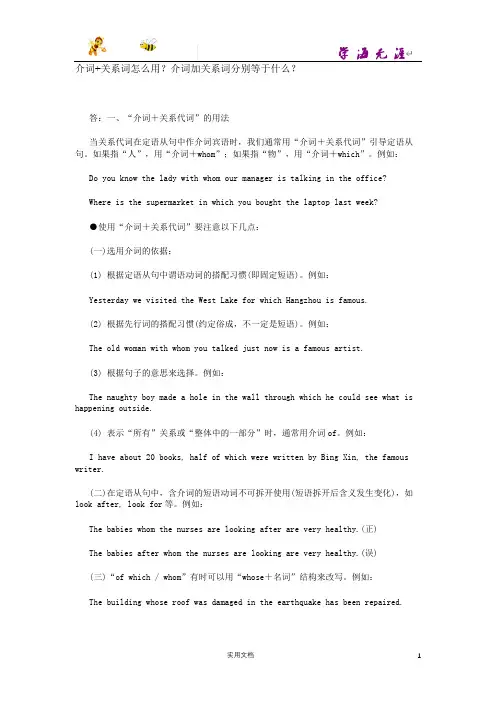
介词+关系词怎么用?介词加关系词分别等于什么?答:一、“介词+关系代词”的用法当关系代词在定语从句中作介词宾语时,我们通常用“介词+关系代词”引导定语从句。
如果指“人”,用“介词+whom”;如果指“物”,用“介词+which”。
例如:Do you know the lady with whom our manager is talking in the office?Where is the supermarket in which you bought the laptop last week?●使用“介词+关系代词”要注意以下几点:(一)选用介词的依据:(1) 根据定语从句中谓语动词的搭配习惯(即固定短语)。
例如:Yesterday we visited the West Lake for which Hangzhou is famous.(2) 根据先行词的搭配习惯(约定俗成,不一定是短语)。
例如:The old woman with whom you talked just now is a famous artist.(3) 根据句子的意思来选择。
例如:The naughty boy made a hole in the wall through which he could see what is happening outside.(4) 表示“所有”关系或“整体中的一部分”时,通常用介词of。
例如:I have about 20 books, half of which were written by Bing Xin, the famous writer.(二)在定语从句中,含介词的短语动词不可拆开使用(短语拆开后含义发生变化),如look after, look for等。
例如:The babies whom the nurses are looking after are very healthy.(正)The babies after whom the nurses are looking are very healthy.(误)(三)“of which / whom”有时可以用“whose+名词”结构来改写。
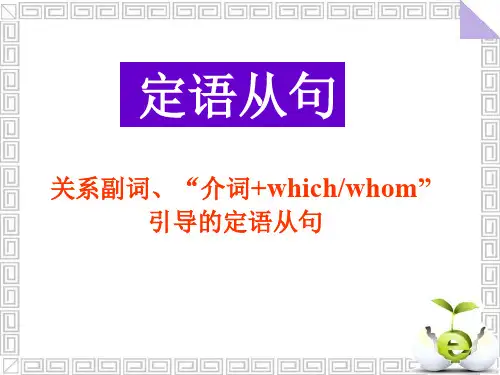
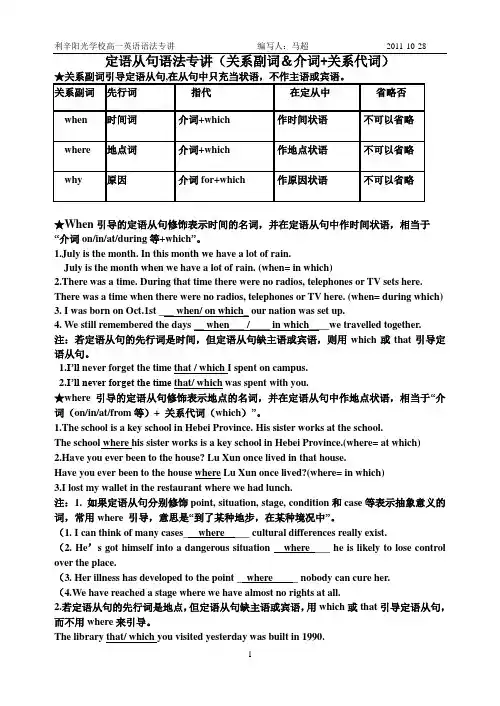
定语从句语法专讲(关系副词&介词+关系代词)★When引导的定语从句修饰表示时间的名词,并在定语从句中作时间状语,相当于“介词on/in/at/during等+which”。
1.July is the month. In this month we have a lot of rain.July is the month when we have a lot of rain. (when= in which)2.There was a time. During that time there were no radios, telephones or TV sets here. There was a time when there were no radios, telephones or TV here. (when= during which)3. I was born on Oct.1st ___ when/ on which_ our nation was set up.4. W e still remembered the days __ when___ /____ in which____we travelled together.注:若定语从句的先行词是时间,但定语从句缺主语或宾语,则用which或that引导定语从句。
1.I’ll never forget the time that / which I spent on campus.2.I’ll never forget the time that/ which was spent with you.★where引导的定语从句修饰表示地点的名词,并在定语从句中作地点状语,相当于“介词(on/in/at/from等)+ 关系代词(which)”。
1.The school is a key school in Hebei Province. His sister works at the school.The school where his sister works is a key school in Hebei Province.(where= at which)2.Have you ever been to the house? Lu Xun once lived in that house.Have you ever been to the house where Lu Xun once lived?(where= in which)3.I lost my wallet in the restaurant where we had lunch.注:1. 如果定语从句分别修饰point, situation, stage, condition和case等表示抽象意义的词,常用where 引导,意思是“到了某种地步,在某种境况中”。
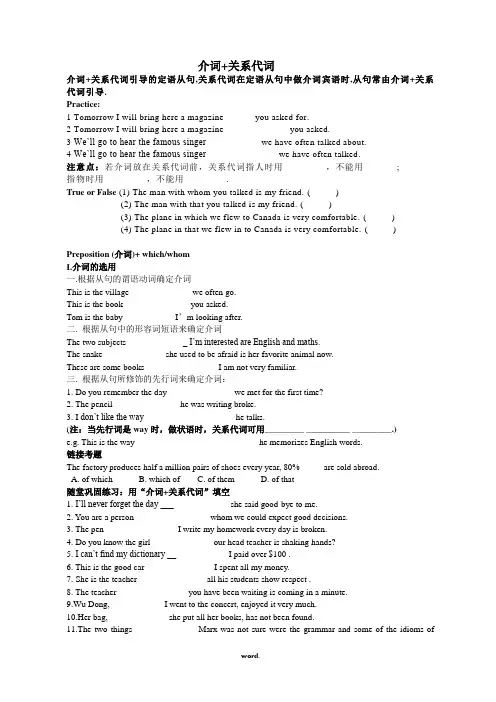
介词+关系代词介词+关系代词引导的定语从句,关系代词在定语从句中做介词宾语时,从句常由介词+关系代词引导.Practice:1 Tomorrow I will bring here a magazine ______ you asked for.2 Tomorrow I will bring here a magazine ______ ______ you asked.3 We’ll go to hear the famous singer ____________we have often talked about.4 We’ll go to hear the famous singer ______ _________ we have often talked.注意点:若介词放在关系代词前,关系代词指人时用________,不能用_______;指物时用_________,不能用_________.True or False (1) The man with whom you talked is my friend. ( )(2) The man with that you talked is my friend. ( )(3) The plane in which we flew to Canada is very comfortable. ( )(4) The plane in that we flew in to Canada is very comfortable. ( )Preposition (介词)+ which/whomI.介词的选用一.根据从句的谓语动词确定介词This is the village ______ _______ we often go.This is the book _______ _______ you asked.Tom is the baby ___________ I’m looking after.二. 根据从句中的形容词短语来确定介词The two subjects ______ _______ I’m interested are English and maths.The snake ______ _______ she used to be afraid is her favorite animal now.These are some books ________ ________I am not very familiar.三. 根据从句所修饰的先行词来确定介词:1. Do you remember the day ______ ________ we met for the first time?2. The pencil ______ ________ he was writing broke.3. I don’t like the way_______ ___________ he talks.(注:当先行词是way时,做状语时,关系代词可用_________ __________ _________.)e.g. This is the way____________________________ he memorizes English words.链接考题The factory produces half a million pairs of shoes every year, 80% _____are sold abroad.A. of whichB. which ofC. of themD. of that随堂巩固练习:用“介词+关系代词”填空1. I’ll never forget the day ______ _________ she said good-bye to me.2. You are a person _______ _________ whom we could expect good decisions.3. The pen _______ _________I write my homework every day is broken.4. Do you know the girl ______ _______ our head teacher is shaking hands?5. I can’t find my dictionary ______ _______ I paid over $100 .6. This is the good car _______ ________I spent all my money.7. She is the teacher _______ ________all his students show respect .8. The teacher _______ ________ you have been waiting is coming in a minute.9.Wu Dong, ____ _______ I went to the concert, enjoyed it very much.10.Her bag, _____ ________she put all her books, has not been found.11.The two things ______ _______ Marx was not sure were the grammar and some of the idioms ofEnglish.12. Recently I bought an ancient Chinese vase, the price _____ ______ was very reasonable.II. “介词+关系代词”(of+whom/which)前可有some, any, none, both, all, neither, most, each, few等代词或者数词.(1) He loved his parents deeply, both of whom are very kind to him.(2) In the basket there are quite many apples, some of which have gone bad.Practice:There are forty students in our class in all,_____________________(大部分的学生是男生)。
![关系副词和“介词+关系代词”引导的定语从句教案[精.选]](https://uimg.taocdn.com/d19bb764f705cc17552709e0.webp)
word.教学过程一、课堂导入给出定语从句,分析主句和从句:Beijing is the place where (in which) I was born.北京是我的出生地。
Is this the reason why (for which) he refused our offer?这就是他拒绝我们帮助他的理由吗?word.二、复习预习把两个单句改成定语从句:The days are gone. During those days we used “foreign oil”.The days when we used “foreign oil” are gone.I still remember the day. On that day the old scientist took us to the physics lab for the first time.I still remember the day when the old scientist took us to the physics lab for the first time.word.三、知识讲解知识点1:关系副词的作用。
word.知识点2:when的用法:when表示时间,在定语从句中作时间状语,其先行词一般为表示时间的名词。
October 1st, 1949 was the day when the People's Republic of China was founded.1949年10月1日是中华人民共和国成立的日子。
word.知识点3:where的用法:1.【考查点】where表示地点,在定语从句中作地点状语,其先行词一般为表示地点的名词。
Is there a shop around where we can get fruit?附近有没有我们能买到水果的地方?word.2.【考查点】where表示地点的模糊化高考试题中对于where的考查趋于复杂。
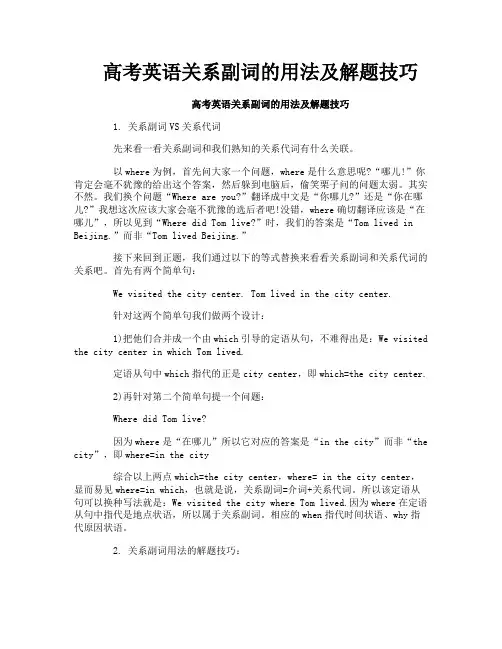
高考英语关系副词的用法及解题技巧高考英语关系副词的用法及解题技巧1. 关系副词VS关系代词先来看一看关系副词和我们熟知的关系代词有什么关联。
以where为例,首先问大家一个问题,where是什么意思呢?“哪儿!”你肯定会毫不犹豫的给出这个答案,然后躲到电脑后,偷笑栗子问的问题太弱。
其实不然。
我们换个问题“Where are you?”翻译成中文是“你哪儿?”还是“你在哪儿?”我想这次应该大家会毫不犹豫的选后者吧!没错,where确切翻译应该是“在哪儿”,所以见到“Where did Tom live?”时,我们的答案是“Tom lived in Beijing.”而非“Tom lived Beijing.”接下来回到正题,我们通过以下的等式替换来看看关系副词和关系代词的关系吧。
首先有两个简单句:We visited the city center. Tom lived in the city center.针对这两个简单句我们做两个设计:1)把他们合并成一个由which引导的定语从句,不难得出是:We visited the city center in which Tom lived.定语从句中which指代的正是city center,即which=the city center.2)再针对第二个简单句提一个问题:Where did Tom live?因为where是“在哪儿”所以它对应的答案是“in the city”而非“the city”,即where=in the city综合以上两点which=the city center,where= in the city center,显而易见where=in which,也就是说,关系副词=介词+关系代词。
所以该定语从句可以换种写法就是:We visited the city where Tom lived.因为where在定语从句中指代是地点状语,所以属于关系副词。
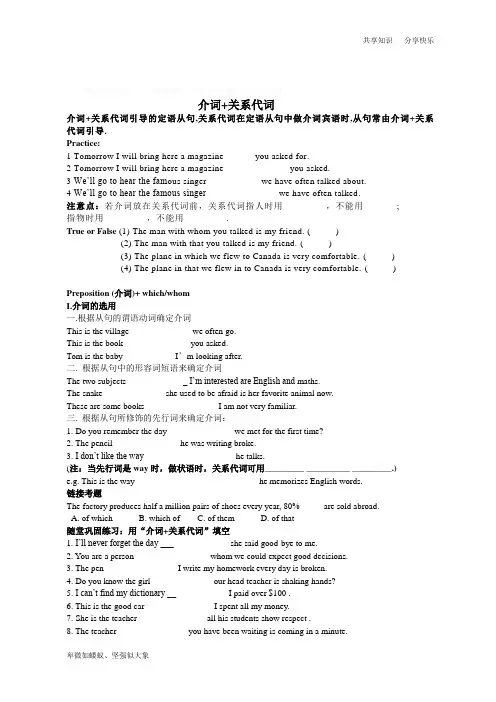
盛年不重来,一日难再晨。
及时宜自勉,岁月不待人。
介词+关系代词介词+关系代词引导的定语从句,关系代词在定语从句中做介词宾语时,从句常由介词+关系代词引导.Practice:1 Tomorrow I will bring here a magazine ______ you asked for.2 Tomorrow I will bring here a magazine ______ ______ you asked.3 We’ll go to hear the fam ous singer ____________we have often talked about.4 We’ll go to hear the famous singer ______ _________ we have often talked.注意点:若介词放在关系代词前,关系代词指人时用________,不能用_______;指物时用_________,不能用_________.True or False (1) The man with whom you talked is my friend. ( )(2) The man with that you talked is my friend. ( )(3) The plane in which we flew to Canada is very comfortable. ( )(4) The plane in that we flew in to Canada is very comfortable. ( )Preposition (介词)+ which/whomI.介词的选用一.根据从句的谓语动词确定介词This is the village ______ _______ we often go.This is the book _______ _______ you asked.Tom is the baby ___________ I’m looking after.二. 根据从句中的形容词短语来确定介词The two subjects ______ _______ I’m interested are English and maths.The snake ______ _______ she used to be afraid is her favorite animal now.These are some books ________ ________I am not very familiar.三. 根据从句所修饰的先行词来确定介词:1. Do you remember the day ______ ________ we met for the first time?2. The pencil ______ ________ he was writing broke.3. I don’t like the way_______ ___________ he talks.(注:当先行词是way时,做状语时,关系代词可用_________ __________ _________.)e.g. This is the way____________________________ he memorizes English words.链接考题The factory produces half a million pairs of shoes every year, 80% _____are sold abroad.A. of whichB. which ofC. of themD. of that随堂巩固练习:用“介词+关系代词”填空1. I’ll never forget the day ______ _________ she said good-bye to me.2. You are a person _______ _________ whom we could expect good decisions.3. The pen _______ _________I write my homework every day is broken.4. Do you know the girl ______ _______ our head teacher is shaking hands?5. I can’t find my dictionary ______ _______ I paid over $100 .6. This is the good car _______ ________I spent all my money.7. She is the teacher _______ ________all his students show respect .8. The teacher _______ ________ you have been waiting is coming in a minute.9.Wu Dong, ____ _______ I went to the concert, enjoyed it very much.10.Her bag, _____ ________she put all her books, has not been found.11.The two things ______ _______ Marx was not sure were the grammar and some of the idioms of English.12. Recently I bought an ancient Chinese vase, the price _____ ______ was very reasonable.II. “介词+关系代词”(of+whom/which)前可有some, any, none, both, all, neither, most, each, few等代词或者数词.(1) He loved his parents deeply, both of whom are very kind to him.(2) In the basket there are quite many apples, some of which have gone bad.Practice:There are forty students in our class in all,_____________________(大部分的学生是男生)。
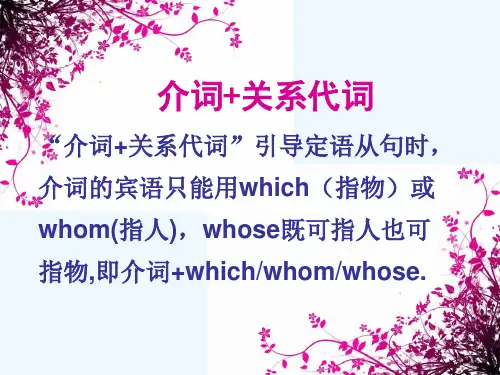
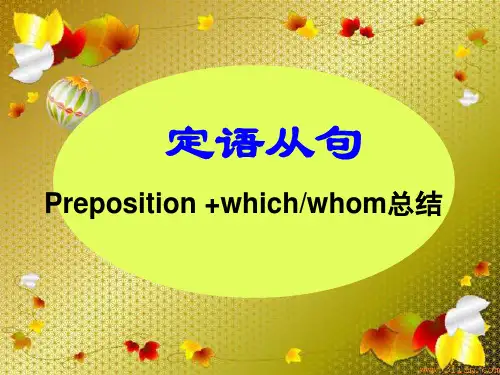

高中英语知识点归纳定语从句的引导词和句型定语从句是高中英语中非常重要的语法知识点之一。
在句子中,定语从句用于修饰名词或代词,进一步说明或限定其前面的名词或代词。
在定语从句中,引导词起到连接主句和从句的作用。
熟练掌握定语从句的引导词和句型对于理解和运用英语句子的结构非常关键。
下面将对定语从句的引导词和句型进行归纳:一、引导定语从句的关系代词:1. 关系代词“that”:- 用于修饰人和物,常出现在被修饰词前面。
- 在非限制性定语从句中,通常用“which”代替。
2. 关系代词“which”:- 用于修饰物,常出现在被修饰词前面。
- 在非限制性定语从句中,通常用“which”代替。
3. 关系代词“who”:- 用于修饰人,在从句中作主语,出现在被修饰词前面。
- 在非限制性定语从句中,通常用“whom”代替。
4. 关系代词“whom”:- 用于修饰人,在从句中作宾语,出现在被修饰词前面。
- 在非限制性定语从句中,通常用“who”代替。
5. 关系代词“whose”:- 用于修饰人和物,表示所属关系。
二、引导定语从句的关系副词:1. 关系副词“where”:- 用于修饰地点,在从句中作地点状语。
- 在非限制性定语从句中,通常用“in/at which”代替。
2. 关系副词“when”:- 用于修饰时间,在从句中作时间状语。
- 在非限制性定语从句中,通常用“at which”代替。
三、定语从句的句型:1. “介词+关系代词/关系副词”:- 介词可以是“in”,“on”,“with”等等,关系代词或关系副词用来引导定语从句。
2. “先行词+关系代词+不定式”:- 先行词常为不定代词,如“something”,“anything”,“nothing”等等,关系代词用来引导定语从句。
3. “as”的使用:- 当先行词是“such”,“the same”,“so”等修饰词时,可以用“as”作为关系词引导定语从句。
以上是定语从句的引导词和句型的归纳总结。
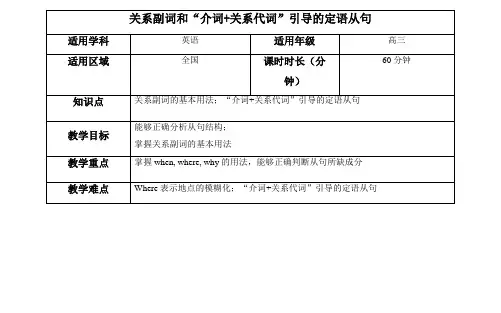
教学过程一、课堂导入给出定语从句,分析主句和从句:Beijing is the place where (in which) I was born.北京是我的出生地。
Is this the reason why (for which) he refused our offer?这就是他拒绝我们帮助他的理由吗?二、复习预习把两个单句改成定语从句:The days are gone. During those days we used “foreign oil”.The days when we used “foreign oil” are gone.I still remember the day. On that day the old scientist took us to the physics lab for the first time.I still remember the day when the old scientist took us to the physics lab for the first time.三、知识讲解知识点1:关系副词的作用。
when表示时间,在定语从句中作时间状语,其先行词一般为表示时间的名词。
October 1st, 1949 was the day when the People's Republic of China was founded.1949年10月1日是中华人民共和国成立的日子。
1.【考查点】where表示地点,在定语从句中作地点状语,其先行词一般为表示地点的名词。
Is there a shop around where we can get fruit?附近有没有我们能买到水果的地方?2.【考查点】where表示地点的模糊化高考试题中对于where的考查趋于复杂。
在定语从句中对先行词的考查从明显的"地点"转化为"地点模糊化",这无疑增加了考生的解题难度,所以有必要对where考点进行辨析。